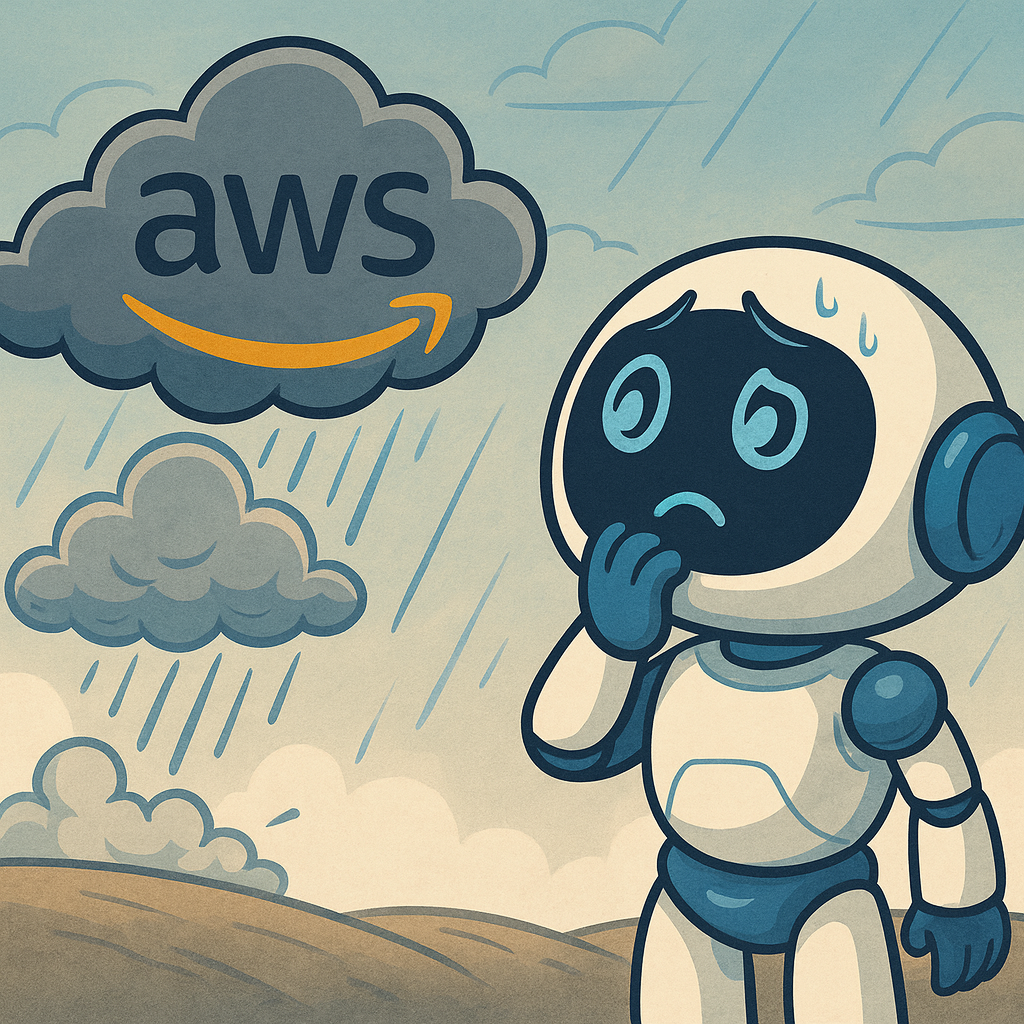When the Cloud Falls: What Happened to Amazon AWS and Why It Affected the Whole World

The recent AWS outage gained global attention by bringing down apps, websites, and systems from various companies. From the moment instability began until services were restored, millions of people were affected—many without even knowing what AWS is. In this article, we’ll explain in a clear and accessible way what happened to Amazon’s cloud, why it impacts so many services at once, and what this reveals about our dependence on digital infrastructure.
What is AWS and why is it so important?
Amazon Web Services (AWS) is Amazon’s cloud computing division. It provides servers, storage, databases, networks, artificial intelligence, and dozens of other services to companies of all sizes. An AWS outage has cascading effects because millions of websites and apps rely on its infrastructure—including streaming platforms, banks, social networks, corporate tools, and even public services.
Today, it’s estimated that about 30% of the global internet passes through AWS servers in some way. When a failure occurs, it’s not just “a website is down”—it’s a whole set of resources supporting hundreds of interdependent services. That’s why an AWS outage can feel like a “global digital blackout.”
Additionally, AWS operates in over 30 global regions, with strategically distributed data centers. This ensures performance but also complexity—and when one of these regions experiences failure, the impact may be local or widespread depending on the architecture of each client.
Understanding what causes an AWS outage
AWS outages are usually caused by technical failures in critical infrastructure, such as server overloads, load balancer errors, misconfigured updates, or network malfunctions. Sometimes, a single misstep—like a poorly tested update—can trigger chain reactions.
Another contributing factor is dependency. Many services rely on multiple AWS components: databases, authentication, file storage, email sending, and more. If one part fails, the entire application may become unusable.
For example, if the IAM (Identity and Access Management) service is unstable, users may not be able to log in—even if the rest of the system is fine.
Services affected by the AWS outage
The AWS outage affected streaming platforms, banks, social media, delivery apps, and even government services. Among those impacted in recent incidents:
- ChatGPT (OpenAI)
- Disney+
- Slack
- Zoom
- iFood
- PicPay
- E-commerce platforms like Shopify
- Hospitals and electronic medical record systems
The impact wasn’t just technical—it was also economic. Retailers lost sales, businesses went down for hours, and users vented on social media. It’s estimated that extended AWS outages can result in losses of millions of dollars per hour globally.
Why do so many companies rely on Amazon’s cloud?
The widespread adoption of AWS is due to its reliability, scalability, and robust ecosystem. Instead of maintaining their own physical servers, companies rent resources on demand, paying only for what they use. This reduces costs and accelerates innovation.
AWS also offers advanced tools for big data, machine learning, security, and automation—attractive to both startups and corporate giants. The problem arises when too many business layers are concentrated in a single cloud provider, with no redundancy.
The AWS outage reveals this exact risk: excessive centralization. Even with uptime guarantees close to 99.9%, failures do happen—and when they do, the effect is massive.
How does an AWS outage affect other services?
When AWS experiences instability, it compromises APIs, app servers, authentication services, and databases used by thousands of companies. This directly impacts the functionality of apps and platforms relying on these resources.
Additionally, many businesses use serverless solutions—where code runs only when needed—which depends entirely on cloud availability. If execution services fail, the applications simply don’t run.
Another critical point is services that use multi-region resources. A network issue between AWS regions can result in data inconsistencies, degraded performance, or unexpected failures in systems operating at a global scale.
Can an AWS outage be avoided entirely?
Completely avoiding it? Not really. But minimizing the impact? Absolutely. Companies can adopt high-availability strategies, multi-cloud architecture (using providers like Microsoft Azure or Google Cloud alongside AWS), data backups, geographic replicas, and automated failovers.
That said, these measures raise both complexity and cost—often becoming unfeasible for small and medium-sized businesses. Many opt for the simplicity and power of AWS, accepting the risks in exchange for agility and scalability.
The AWS outage serves as a wake-up call: digital resilience starts at the architecture level. It’s not enough to rely on “the cloud”; we must design systems with fault tolerance, monitoring, and fallback mechanisms in place.
The role of observability and real-time monitoring
During large-scale outages, observability becomes essential. Monitoring tools such as Datadog, New Relic, Prometheus, or Grafana allow companies to detect anomalies in real time—like latency spikes, database timeouts, or API failures.
Dashboards and automated alerts help identify whether the root cause is internal or external (such as AWS), enabling faster responses and better incident management. Companies with strong observability recover faster, while those without it may remain in the dark for hours.
Observability is no longer a luxury—it’s a critical pillar of operational continuity and customer trust.
The importance of communication during an AWS outage
When an outage like this occurs, transparent and timely communication is vital. Companies that quickly acknowledge the issue, provide updates, and set expectations generate trust—even amidst disruption.
AWS provides a public status page (status.aws.amazon.com) with real-time incident reports. However, affected companies also need to communicate through their own channels—email, social media, status pages—to explain what’s happening and manage user expectations.
Clear crisis communication helps preserve brand reputation and keeps users informed, which reduces frustration and speculation.
How consumers are affected—without knowing
Many users don’t know what “cloud” or “AWS” means, yet use dozens of services powered by Amazon’s infrastructure daily. When something breaks, they often blame the app, site, or brand—unaware that the root cause lies with a backend provider.
The AWS outage shows just how interconnected our digital lives are. A glitch in one invisible layer can cascade into disruptions across social networks, financial apps, communication platforms, and more.
Understanding the basics of cloud infrastructure gives consumers more clarity—and patience—when issues arise. It also highlights the importance of digital literacy in the age of invisible dependencies.
Lessons learned from the AWS outage
Every incident like this offers important lessons. For businesses: don’t overcentralize infrastructure. For developers: build for failure. For users: be aware of how modern services are interconnected and reliant on shared infrastructure.
From a strategic standpoint, it also pushes the conversation forward on topics such as cloud sovereignty, resilience engineering, and vendor diversification. As critical infrastructure increasingly moves to the cloud, so must the governance and responsibility to keep it running smoothly.
The AWS outage wasn’t just a technical glitch—it was a reminder of our digital interdependence.
Conclusion — The cloud is powerful, but not invincible
The AWS outage proves that even the most advanced systems are vulnerable to failure. The cloud offers unprecedented power—scalability, flexibility, cost-efficiency—but it requires responsible architecture, good governance, and contingency planning.
For consumers, it’s a call for greater digital awareness. For businesses, a prompt to invest in observability, redundancy, and crisis communication. For the tech ecosystem, it’s a chance to design infrastructure that’s not only scalable—but resilient.
Because when the cloud falls, the whole world feels it. And the best we can do is prepare, adapt, and build stronger foundations for what comes next.
📣 Want to learn more about AI, automation, and cloud infrastructure?
Check out our article How to Train ChatGPT with Your Own Data and subscribe to the TechInNess newsletter to get exclusive PDFs and practical guides every week!
💬 Frequently Asked Questions (FAQ)
- What is AWS? Amazon Web Services is Amazon’s cloud platform used by millions of websites and apps worldwide.
- Why does an AWS outage affect so many services? Because many companies depend on AWS for hosting, databases, APIs, and storage.
- How can I tell if a service is down due to AWS? You can check AWS’s status page or follow updates from the affected company.
- Is it still safe to trust the cloud? Yes. Outages are rare, and cloud platforms are generally more secure than local infrastructure.
- How can companies reduce the impact of future outages? By implementing backups, multi-cloud strategies, and failover systems.
- What are alternatives to AWS? Microsoft Azure, Google Cloud Platform, Oracle Cloud, IBM Cloud, and others.



